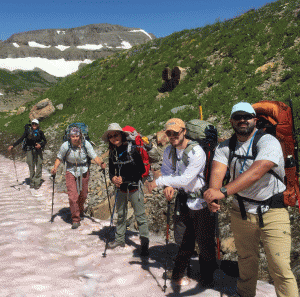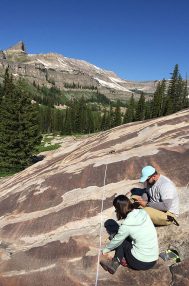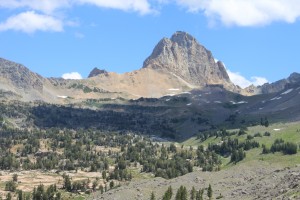
Field party 2018
Initiative researchers have for the first time quantified fractal clustering of fractures in basement rocks. The study demonstrates self-organized clustering over a length scale range from 10-2 to 101 m for opening-mode fractures in texturally homogeneous granitic rock in the Teton range, Wyoming. This example and the rigorous spatial arrangement method used in the study provide essential insights for understanding fracture patterns and fluid flow in other less accessible fractured basement rocks.
The research was conducted on fractures in Late Archean Mount Owen Quartz Monzonite in the Teton Range, Wyoming. The study is part of Qiqi Wang’s dissertation research on how fracture spatial arrangement patterns arise.
Fracture spatial arrangement is a key aspect of the structural heterogeneity of the brittle crust. Understanding the spatial arrangement of opening-mode fractures (joints and veins) has great practical importance and is essential for managing exploration and engineering operations in subsurface rocks. Fracture-enhanced permeability is important in aquifers, waste repositories, hydrothermal systems, and petroleum reservoirs including those in basement rocks.
Recent major discoveries of oil in fractured basement rocks in the North Sea depend on natural fractures for both fluid flow and storage.

Measuring fractures
Typical of fracture-controlled permeability is tremendous heterogeneity and anisotropy in fluid flow. Although fracture network permeability is governed by many factors including aperture and length distributions and connectivity, and by whether fractures are open or sealed, a common cause of permeability variability is heterogeneous spatial arrangement.
Spatial arrangement describes fracture positions, including whether fractures are clustered, randomly placed or evenly spaced. This study used the recently introduced Normalized Correlation Count (NCC) method of Marrett et al. to describe fracture spatial arrangement in a large exposure of texturally uniform granitic rock. NCC accounts for sequences of spacings, including non-neighbor spacings.
The technique was implemented with the freely available software CorrCount, accessible via the open-access Marrett et al. paper. We compare results with conventional spacing analysis methods: descriptive statistics and ratio of standard deviation to mean or coefficient of variation (Cv).
The example illustrates how NCC can quantify spatial arrangement over a wide range of length scales, measure the pattern and degree of clustering, and test the statistical significance of the results. The same method was used to assess spatial arrangement patterns in six other previously published fractured granite data sets, finding a range of degrees and patterns of clustering. As the first application of the NCC technique to fractures in granitic rocks, the study shows that opening-mode joints in granites have patterns that range from power-law clustering to indistinguishable from random.
Qiqi Wang will present the results of the study at the AAPG ACE in San Antonio on May 20. See presentation information
Getting There
Field work was conducted in the Teton backcountry in the summer and fall of 2018. We are grateful for research access to the Jedidiah Smith Wilderness to Diane Wheeler and Jay Pence, U.S. Forest Service and to Grand Teton National Park for permission under National Park Service research permits. Stephanie R. Forstner and Finn Tierney assisted with field work, I.A.M., E.C., and A.M. Laubach provided essential field support. Leonel Gomez and John Hooker provided guidance and feedback on the analysis methods. We appreciate insights from members of the 2018 trans-Tetons field trip, including Sergio Sarmiento, Tiago Miranda, Thiago Falcão, Marcus Ebner, Rodrigo Correia, and Lane Boyer. Qiqi’s research is supported by grant DE-FG02-03ER15430 from Chemical Sciences, Geosciences and Biosciences Division, Office of Basic Energy Sciences, Office of Science, U.S. Department of Energy, and by the Fracture Research and Application Consortium.

Buck Mountain and Buck Mountain fault from Teton Canyon
The exposures described in the Wang et al. paper are spectacular—even for non-geologists. But for structural geologists with an interest in fractures, they ought to be on a top-ten bucket list.
The outcrops are easy to find, and are crossed by a major trail. The closest access is via the Teton Canyon trail head on the Idaho side of the Teton range. Following the South Teton Canyon/Alaska Basin Trail, the mostly gentle climb ascends from around 6967 ft to 8630 ft in a little over 5 miles to the edge of the exposure. Past the outcrop, in short order the trail brings you to the alpine Basin Lakes.
An initiative field group will visit these outcrops in late summer 2019 as part of ongoing research on fractures within the range. The plan is to enter the Teton range from the west, the Idaho side, and traverse across to Jackson Hole with one or two nights of camping. This ca. 39 km jaunt gets us to two interesting outcrops on the west side of the Tetons and the interesting fault outcrop in the central Tetons at Kit Lake. It is a very scenic walk.
Contact Steve Laubach or Qiqi Wang for more information.
Read the Papers
The Marrett et al. paper received the AAPG Petroleum Structure & Geomechanics Division Best Recent Paper Award in May 2019.
Both papers are published open access, and are accessible via the links:
Marrett, R., Gale, J.F.W., Gomez, L., and Laubach, S.E., 2018. Correlation analysis of fracture arrangement in space. Journal of Structural Geology 108, 16-33. doi.org/10.1016/j.jsg.2017.06.012 | view
Wang, Q., Laubach, S.E., Gale, J.F.W., and Ramos, M.J., 2019. Quantified fracture (joint) clustering in Archean basement, Wyoming: application of Normalized Correlation Count method. Petroleum Geoscience. doi:10.1144/petgeo2018-146 | view
Acknowledgements
Our research on the structural diagenesis of fractures is supported by Grant DE-FG02-03ER15430 from Chemical Sciences, Geosciences and Biosciences Division, Office of Basic Energy Sciences, Office of Science, U.S. Department of Energy.
© 2024 Jackson School of Geosciences, The University of Texas at Austin


